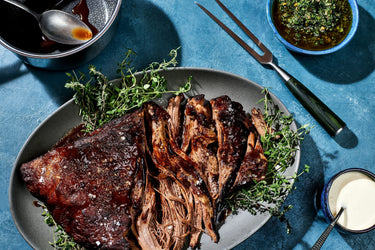Nancy Silverton's Tips for Better Brisket

If you’re making brisket, make it count. And by “count,” we mean fall-apart tender and deeply flavorful—and possibly the best brisket of your life. Fortunately, Nancy Silverton, chef, cookbook author and co-owner of the Mozza Restaurant Group, has you covered with her Brisket al Forno (Italian for “in the oven”).
Her recipe leans into long, gentle cooking and a few upgrades from the version she grew up eating. “No matter what, everybody thinks they make a great brisket,” Nancy says. “People are overconfident, but it can be so much better.” We checked in with Nancy, a member of our esteemed Culinary Council, to get her tips for turning a good brisket into a great one.

1. Lean away from extra-lean
Though you might have grown up being told that extra-lean brisket is ideal, that’s the first mistake. “You want a brisket that has a lot of fat in it,” Nancy advises. Fat is what gives the meat its tenderness after a long cook, helping you avoid the dry, tough texture that characterizes subpar brisket. If you’re buying from a butcher and luck into a piece with a good half-inch cap of fat, you’ll want to trim it down a bit, but not remove it. On the other hand, supermarket brisket tends to be much leaner, so don’t go overboard with trimming. “If you’re lucky enough to procure a brisket that has a good half-inch of fat on there, then you want to trim it down a little, but not remove it,” Nancy says.
2. Great brisket is a three-day affair
Nancy grew up with brisket on the table regularly. “My mom wasn’t a typical cook in the era of convenience food. Lots of my friends grew up on TV dinners,” she says. “That was not in my household. When she made something, she went all in.” Her mom’s brisket was comfort food, made with care and the usual suspects: stock, vegetables and plenty of time.
Nancy’s version nods to that original while dialing things up. She adds beer to the braising liquid and moves the whole thing from stovetop to oven for a gentler, more even cook. But the biggest shift? Time. “My mom’s brisket was a one-day meal,” she explains. Nancy’s, on the other hand, unfolds over three deliberate days: seasoning on day one, braising on day two and resting overnight for a final day-three payoff. The result is brisket with depth, tenderness and intensity that goes well beyond the usual Sunday supper. In short? Don’t rush the process.
3. Treat your brisket like any classic braise
If you’ve made a classic braise, then you know how to do this. “I treat a brisket like I would any braise,” Nancy said. In other words, a brisket has the same basic steps as a beef stew: season, braise, rest, serve. “While it’s going to take longer because the piece of brisket is much bigger than in a beef stew, the flavor of the braise is similarly important,” Nancy explains. Season the meat the day before, then create a flavorful braising liquid and cook it low and slow.
4. Braising liquid equals flavor
You might be tempted to ask, “Why not braise to tender in water?” But as Nancy points out, that would mean sacrificing flavor: “That’s what the protein is soaking up—the flavor of that braising liquid.” Hers starts with the usual suspects: a bottle of red wine, good stock, and a base of onions, carrot, celery and parsley. But she doesn’t stop there. Nancy layers in an entire head of garlic, fennel, mustard seeds, chile de árbol and stout. If you have time to make your own stock, our Big Batch Bone Broth is practically begging for an invitation to your brisket party.

5. Pair it with flavor bombs
Meat this rich calls for bold accompaniments. “We serve the brisket with two sauces either on the side or on or underneath: a salsa verde that we paint on at the end and a very pungent horseradish cream. I love the three together. It’s like a flavor bomb," Nancy says. The salsa verde is chunky, herb-packed and tangy, while the horseradish cream brings sharpness and heat to cut through the richness of the meat and jus. If the cream feels a bit stiff, Nancy has an easy fix: “If you find your horseradish cream is too thick, add some of the liquid from prepared horseradish back into it to thin it out."
6. Leftovers are the best part
Nancy’s brisket isn’t just great the first time around. It’s built for reinvention. “You could make a hash, or you can incorporate it into a pasta. We use it as part of a brisket bowl, and use a hunk of it in a bowl with hard-cooked eggs, steamed whole small potatoes that are tossed in a lot of parsley and good salt, maybe some roasted scallions or onions, or roasted carrots, and turn it into a breakfast entrée.”
We came for the braise, stayed for the sauces and will absolutely be making that breakfast bowl. Get the brisket recipe here!
*Quotes have been edited and condensed for clarity.





